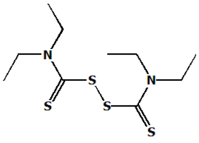Results of a study funded by the National Institute on Drug Abuse (NIDA), National Institutes of Health, suggest that disulfiram, a medication used to treat alcohol addiction, is effective in combating cocaine abuse. The researchers also conclude in the same study that combining disulfiram with behavioral therapy provides more positive results in treating cocaine dependence than disulfiram in combination with another form of therapy. The research is published in the March 2004 issue of the Archives of General Psychiatry.
In the study, 121 cocaine-dependent individuals randomly were assigned to receive disulfiram (also known as Antabuse) or a placebo, in addition to undergoing one of two behavioral therapy interventions. Participants received either cognitive behavioral therapy (CBT) or interpersonal psychotherapy (IPT) in individual sessions during the 12-week project. Results showed that participants given disulfiram reduced their cocaine use significantly compared with people given placebo. In addition, those who received disulfiram in combination with CBT reduced their cocaine use compared with those who received disulfiram in combination with IPT. Lead investigator Dr. Kathleen Carroll, of Yale University School of Medicine, and her colleagues also report that benefits seen with disulfiram and CBT were most pronounced for people who were not alcohol dependent or who abstained fully from alcohol during therapy.
"About 60 percent of people dependent on cocaine also abuse alcohol, so it was thought you could reduce cocaine abuse by targeting the accompanying codependence on alcohol," says NIDA Director Dr. Nora D. Volkow. "But these results suggest that disulfiram exerts a direct effect on cocaine use, rather than reducing concurrent alcohol use. More research is needed about whether combining disulfiram with CBT provides an even more effective tool for treating cocaine dependence."
Disulfiram is one of two medications approved by the Food and Drug Administration (PDA) for treating alcohol abuse. It interferes with the metabolism of alcohol, producing aversive reactions such as nausea and vomiting when alcohol is ingested. The FDA notes that aversive reactions may also occur when patients taking disulfiram use cocaine.
Cognitive behavioral therapy (CBT) theory holds that surroundings strongly influence a person's thinking and behavior, so CB therapists teach their patients new ways of acting and thinking in response to their environments. In the case of CBT for addiction, patients are urged to avoid situations that lead to drug use and to practice drug refusal skills. Interpersonal psychotherapy (ITP) is based on the concept that many psychiatric disorders, including cocaine dependence, are related intimately to disorders in interpersonal functioning, which may be related to the origin or perpetuation of the disorders.
This update was provided by the National Institute on Drug Abuse which is a component of the National. Institutes of Health, U.S. Department of Health and Human Services. NIDA supports more than 85 percent of the world's research on the health aspects of drug abuse and addiction. The Institute carries out a large variety of programs to ensure the rapid dissemination of research information and its implementation in policy and practice. Fact sheets on the health effects of drugs of abuse and information on NIDA research and other activities can be found on the NIDA home page at .
Copyright Nevada Nurses Association May 2004
Provided by ProQuest Information and Learning Company. All rights Reserved



